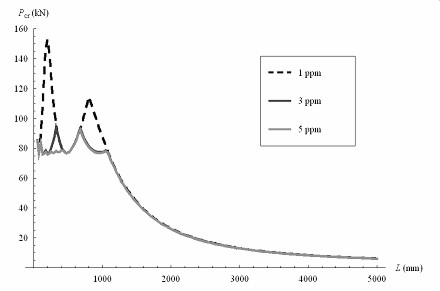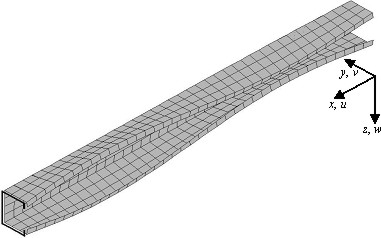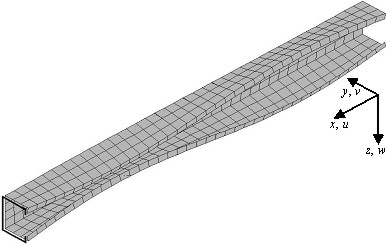
engineering & technology publications
ISSN 1759-3433
PROCEEDINGS OF THE TENTH INTERNATIONAL CONFERENCE ON CIVIL, STRUCTURAL AND ENVIRONMENTAL ENGINEERING COMPUTING
Post-Buckling Analysis of Thin-Walled Channel Columns in the Framework of the Generalized Beam Theory
Civil Engineering Department, University of Coimbra, Portugal
To illustrate the concepts just presented, a thin-walled channel section is analysed in the buckling and post-buckling domain. It is noted that four buckling zones occur, depending of the member's length, although only three were presented here - see Figure 38.1. For a member whose length falls in the distortional length range, the post-buckling behaviour was analysed by computing the equilibrium paths and the evolution of stresses and displacements beyond bifurcation. The post-critical behaviour is shown to be stable, although little additional load capacity occurs after buckling. Figure 38.2 illustrates the member general configuration for a load level P equal to 1.078 times the critical load.
|
- 1
- R. Schardt, "Verallgemeinerte Technische Biegetheorie", Springer-Verlag, Berlin-Heidelberg, Germany, 1989.
- 2
- P. Simão, L. Simões da Silva, "A unified energy formulation for the stability analysis of open and closed thin-walled members in the framework of the Generalized Beam Theory", Thin-Walled Structures, 42(10), 1495-1517, 2004. doi:10.1016/j.tws.2004.03.021
- 3
- P. Simão, "Post-buckling analysis of thin-walled prismatic members in the context of the Generalized Beam Theory", PhD Thesis, University of Coimbra, Coimbra, Portugal, 2005 (soon available at http://www.dec.uc.pt/~pedro).
- 4
- P. Simão, L. Simões da Silva, "Post-buckling behaviour of open cross-section thin-walled columns in the context of the Generalized Beam Theory", V.P. Iu, L.N. Lamas, Y.-P. Pi, K.M. Mok (Eds.), Computational Methods in Engineering and Science - Proceedings of the 9th International Conference on Enhancement and Promotion of Computational Methods in Engineering and Science - EPMESC IX, A.A. Balkema Publishers, 891-898, 2003.
- 5
- P. Simão, L. Simões da Silva, "A numerical scheme for post-buckling analysis of thin-walled members in the context of GBT", Proceedings of the International Conference on Computational and Experimental Engineering and Sciences, ICCES 2004, Funchal, Madeira, 2079-2086, 2004.
purchase the full-text of this paper (price £20)
go to the previous paper
go to the next paper
return to the table of contents
return to the book description
purchase this book (price £135 +P&P)


